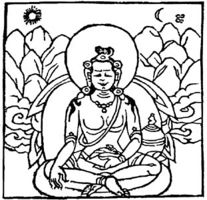Difference between revisions of "Kālacakrapāda"
| (4 intermediate revisions by the same user not shown) | |||
| Line 2: | Line 2: | ||
|pagename=Kālacakrapāda | |pagename=Kālacakrapāda | ||
|PersonType=Authors of Sanskrit Works; Classical Indian Authors | |PersonType=Authors of Sanskrit Works; Classical Indian Authors | ||
| + | |images=File:Kālacakrapāda kalacakra.org.jpg | ||
|HasDrlPage=Yes | |HasDrlPage=Yes | ||
|HasLibPage=Yes | |HasLibPage=Yes | ||
| Line 14: | Line 15: | ||
|AltNamesOther=Manyjuvajra; Cilupa | |AltNamesOther=Manyjuvajra; Cilupa | ||
|BornIn=Varendra (a region of northern Bengal) in eastern India | |BornIn=Varendra (a region of northern Bengal) in eastern India | ||
| − | |TeacherOf=Kha che zla ba mgon po | + | |TeacherOf=Kha che zla ba mgon po; |
| + | Avadhūtipa; | ||
| + | Śrībhadrabodh; | ||
| + | Nālandāpa; | ||
| + | Nāropa; | ||
| + | Sādhuputra; | ||
| + | Ratnakaragupta; | ||
| + | Mokṣakaragupta; | ||
| + | Vinayākaramati; | ||
| + | Siṃhadhvaya; | ||
| + | Anantajaya | ||
|BdrcLink=https://www.tbrc.org/#!rid=P4CZ15084 | |BdrcLink=https://www.tbrc.org/#!rid=P4CZ15084 | ||
| + | |BnwShortPersonBio=The one known as Kālacakrapāda the Elder (Dus zhabs pa chen po) was born in Varendra (a region of northern Bengal) in eastern India. His father was a Brahmin yogin who practised Black Yamāri (Gshin rje gshed nag po), and his mother was an awareness ḍākinī. They performed a ritual from the ''Kṛiṣṇayamāri Tantra'' to ensure the birth of a noble son. The father dreamed of the noble Mañjuśrī entering his wife's belly, and the child was later born together with auspicious signs. | ||
| + | |||
| + | Due to the blessing of noble Mañjuśrī, the child had a bright mind with clear faculties, and took ordination when he was young. He studied many subjects and understanding them all with ease he became a paṇḍita and was known as Cilupa. He heard of Kālacakra from Paṇḍita Ācārya, but was not satisfied, and through the awakening of his previous prayers he developed a powerful wish to go to Sambhala. | ||
| + | |||
| + | As his personal deity Tārā would grant the realization of anything he wished, she prophesied that for the benefit of beings he would gather from Sambhala many tantras and bodhisattva commentaries. | ||
| + | |||
| + | This is a reference to a particular cycle of commentaries, often known as the bodhisattva trilogy (Sems 'grel skor gsum). Said each to have been written by great bodhisattvas, one is the ''Vimalaprabhā'' commentary on Kālacakra, and the other two deal with the Cakrasaṃvara and Hevajra tantras. ([http://www.kalacakra.org/history/khistor3.htm Source Accessed October 16, 2019]) | ||
|IsInGyatsa=No | |IsInGyatsa=No | ||
}} | }} | ||
Revision as of 17:30, 16 October 2019
| Wylie | Dus zhabs pa 'jam pa'i rdo rje |
|---|---|
| English Phonetics | Kālacakrapāda |
- རྣལ་འབྱོར་པ་དུས་ཀྱི་འཁོར་ལོའི་ཞབས
- དུས་ཞབས་པ་ཆེན་པོ
- Rnal 'byor pa dus kyi 'khor lo'i zhabs
- Dus zhabs pa chen po
- Manyjuvajra
- Cilupa
Tibetan calendar dates
- Students
- Kha che zla ba mgon po · Avadhūtipa · Śrībhadrabodh · Nālandāpa · Nāropa · Sādhuputra · Ratnakaragupta · Mokṣakaragupta · Vinayākaramati · Siṃhadhvaya · Anantajaya
Other Biographical info:
- Wiki Pages
- Person description or short bio
- The one known as Kālacakrapāda the Elder (Dus zhabs pa chen po) was born in Varendra (a region of northern Bengal) in eastern India. His father was a Brahmin yogin who practised Black Yamāri (Gshin rje gshed nag po), and his mother was an awareness ḍākinī. They performed a ritual from the Kṛiṣṇayamāri Tantra to ensure the birth of a noble son. The father dreamed of the noble Mañjuśrī entering his wife's belly, and the child was later born together with auspicious signs.
Due to the blessing of noble Mañjuśrī, the child had a bright mind with clear faculties, and took ordination when he was young. He studied many subjects and understanding them all with ease he became a paṇḍita and was known as Cilupa. He heard of Kālacakra from Paṇḍita Ācārya, but was not satisfied, and through the awakening of his previous prayers he developed a powerful wish to go to Sambhala.
As his personal deity Tārā would grant the realization of anything he wished, she prophesied that for the benefit of beings he would gather from Sambhala many tantras and bodhisattva commentaries.
This is a reference to a particular cycle of commentaries, often known as the bodhisattva trilogy (Sems 'grel skor gsum). Said each to have been written by great bodhisattvas, one is the Vimalaprabhā commentary on Kālacakra, and the other two deal with the Cakrasaṃvara and Hevajra tantras. (Source Accessed October 16, 2019)
Expand to see this person's philosophical positions on Buddha-nature.
| Is Buddha-nature considered definitive or provisional? | |
|---|---|
| Position: | |
| Notes: | |
| All beings have Buddha-nature | |
| Position: | |
| If "Qualified", explain: | |
| Notes: | |
| Which Wheel Turning | |
| Position: | |
| Notes: | |
| Yogācāra vs Madhyamaka | |
| Position: | |
| Notes: | |
| Zhentong vs Rangtong | |
| Position: | |
| Notes: | |
| Promotes how many vehicles? | |
| Position: | |
| Notes: | |
| Analytic vs Meditative Tradition | |
| Position: | |
| Notes: | |
| What is Buddha-nature? | |
| Position: | |
| Notes: | |
| Svātantrika (རང་རྒྱུད་) vs Prāsaṅgika (ཐལ་འགྱུར་པ་) | |
| Position: | |
| Notes: | |
| Causal nature of the vajrapāda | |
| Position: | |
